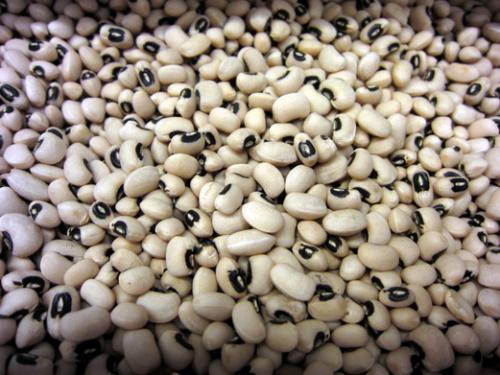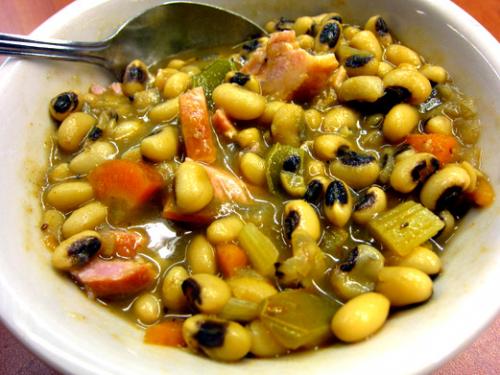Hoppin' John for the New Year
There are certain foods that become cozy comfort foods in your family, the kind that you look forward to at the end of a day of playing in the snow. In our family, Hoppin’ John, a savory stew made primarily from black-eyed peas, has become one of them, a meal enjoyed by all ages.

Black-eyed peas in our Bulk department
The dish originated in the South, where it is traditionally eaten on New Year's Day. Black-eyed peas were brought to the South with the West African slave trade, and did well growing in the new subtropical climate, along with rice. How they came to be associated with New Year's Day and how the dish got its unusual name is a matter of some mystery, however.
According to Tim Carman from the Washington Post:
If writers and scholars disagree on the origin of the name, at least they have something to argue about. There are virtually no established theories about how Hoppin’ John came to symbolize good luck, or how eating it would provide good luck for the coming year. Some point to the notion that the peas resemble coins, which would be true if our pocket change looked like jellybeans. Others note that Hoppin’ John typically is served with braised collard greens, which popularly symbolize paper money.
Taylor [John Martin Taylor, a food historian] suggests that the tradition might (emphasis on “might”) have started during that fallow period between Christmas and New Year’s Day, when slaves were given time off. The harvest season was essentially over, the planting season yet to come. It was a good time to give thanks for past crops, Taylor says, and raise expectations for the coming season. Such a ritual could have developed into a good-luck tradition, with the slaves’ favorite dish of Hoppin’ John as the centerpiece.
One Southern saying alluding to the stew of black-eyed peas and rice goes:
Eat poor that day, eat rich the rest of the year.
Rice for riches and peas for peace.
Regardless of how the dish came to be called Hoppin’ John or associated with the New Year, it generally is a hearty stew of black eyed peas seasoned with onion, green peppers, bay leaf, and cayenne pepper or red chili flakes, and finished with long grain white rice. Ham hock is definitely a must for meat-eaters, which I suppose in the South includes most people. Typical sides are braised collards and cornbread.
Not being from the South, I have no sense of how this dish should taste or adherence to tradition, so over time it’s slowly evolved in my household to become what it is today. The recipe, to the extent that I use one (mostly I don’t), is what my family likes, and what we eat regularly and serve our friends, some of whom now eat it regularly, too.
With apologies to Southerners, here is our family’s version of Hoppin’ John.
I’ll be making this dish in the New Year in my class on cooking sustainable meat and seafood with a focus on local pork: Monday, January 7th, 6-7:30 p.m.
Hoppin' John
1 Tbs. olive oil
1/2 pound uncured bacon or ham
1 yellow onion
1 large carrot
2 stalks celery
2 green peppers (or whatever color your kids will eat)
2 cups black-eyed peas (soaked 8 hours, if time allows, otherwise simply proceed with recipe)
plenty of water to cover the beans
1 bay leaf
1 tsp. oregano or thyme
1 tsp. paprika (use cayenne if you want a spicy kick)
salt/pepper
Heat olive oil in a large, heavy-bottomed pot and lightly brown bacon or ham, about 5 minutes. Dice onion, carrot, celery, and green pepper and cook another 5 minutes. Rinse black-eyed peas and add to pot along with water, water leaf, oregano, and paprika. Bring water to a boil and cook, covered, at a simmer until black-eyed peas are tender but not mushy (about 1 hour) and about 2 cups of liquid remain - about the consistency of a stew. Add salt and pepper to taste.
Serve with cornbread or brown rice on the side (in Southern recipes, you stir 1 1/2 cups long-grain white rice into the beans after about 45 minutes and cook another 20 minutes.) For greens, cook some leafy green kale, or think outside the box and eat with local sauerkraut (a great accompaniment to pork).
